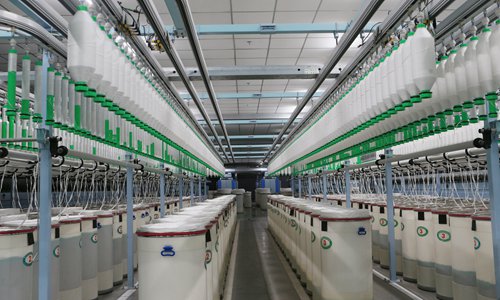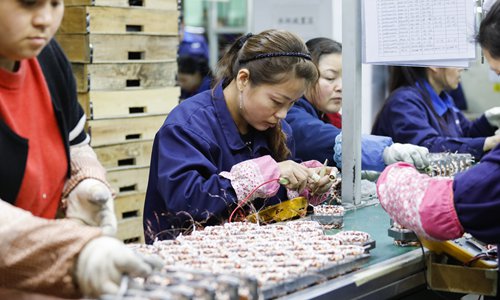HOME >> BUSINESS
Tariff impact under control
Source:Xinhua-Global Times Published: 2019/5/28 17:18:41
China’s manufacturing sector won’t take long-term hit from trade war: analysts

A view of a textile manufacturing line in East China's Jiangsu Province in April. Photo: IC

Inset: Workers process electronic products that will be exported to the US and Europe at a factory in Jiujiang, East China's Jiangxi Province. File photo: IC
Tariff hikes by the US will result in an increase of some operation costs, lower competitiveness and fewer orders for businesses, but their impact on China's manufacturing sector is generally controllable, a senior official told Xinhua in an interview.
The $200 billion worth of Chinese goods on which the US imposed additional tariffs accounts for 41.8 percent of China's exports to the country, but only 8 percent of China's total exports, said Wang Zhijun, vice minister of industry and information technology.
Moreover, about half of the affected enterprises are foreign-funded enterprises, including many US companies, said Wang.
In other words, the tariff hikes hurt not only the interests of Chinese enterprises and consumers, but also US companies and consumers and the global supply chain, said Wang.
Latest statistics from the National Bureau of Statistics (NBS) showed that the value added by China's major industrial firms increased 5.4 percent year-on-year in April, beating market expectations.
In addition, the purchasing managers' index for the manufacturing sector held steady at 50.1, remaining within the expansion range.
NBS statistics also showed that profits of China's major industrial firms fell 3.7 percent year-on-year in April, thanks to a higher base in April last year and an earlier unleashing of market demand in March as a lower value-added tax rate was implemented on April 1.
Li Chao, an analyst with Huatai Research Institute, said that industrial profits would return to positive territory, but how fast will depend on market demand, prices and the policy incentives of tax cuts and fee reductions.
"Trade frictions may amplify short-term fluctuations but will not impact the long-term trend of asset prices based on what happened during the US-Japan and US-EU trade frictions," Li said.
As enterprises may continue to foreload their exports, the data will not worsen in the second quarter, he said.
Better structure
Based on figures from April, China's manufacturing sector has seen improving structure and efficiency. Among the 41 industrial lines, 27 saw higher profits and 14 reported lower earnings in April.
On the positive side, consumer product manufacturers and equipment producers maintained relatively fast profit growth, reflecting structural improvement.
In the period, major special-purpose equipment producers recorded 17.9-percent profit growth, while electrical machinery and device producers' profits climbed 14.5 percent.
The structural change was in line with a shift in China's economic growth drivers from exports and investment to domestic consumption and high-end industries, analysts said.
For every 100 yuan ($14.48) of revenue they generated, the costs they bore fell by 1.1 yuan from a year earlier to 88.7 yuan in April.
Wang said that manufacturing firms' confidence had been enhanced thanks to the gradual unleashing of policy dividends as a result of the country's lower value-added tax rate.
Innovation encouraged
In the long run, innovation will be the main engine to propel the expansion of China's manufacturing industry. To encourage corporate innovation, China unveiled various measures, including establishing a series of innovation centers and laboratories, increasing support for enterprises in key fields and optimizing innovation-oriented policies.
Wang said China will place greater emphasis on innovation in enterprises' development and urge them to increase research and development investment with more tax cuts, funding and loan issuances for innovation projects.
More efforts will be made to facilitate research on core technologies, accelerate the intelligent, green and service-oriented upgrading of the manufacturing industry, and advance the integrated development of the manufacturing industry and industrial internet, Wang said.
While enhancing resource sharing on various research platforms, the country will promote the application of scientific achievements, encourage domestic enterprises to carry out international innovation cooperation and intensify protection of intellectual property.
Despite the disruptions from the increased tariffs imposed by the US, Wang said the country's manufacturing industry has bright prospects.
Official statistics showed that from January to April, actual foreign investment in China's manufacturing sector jumped 11.4 percent year-on-year.